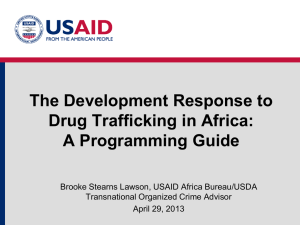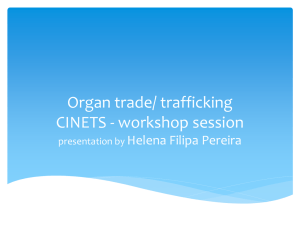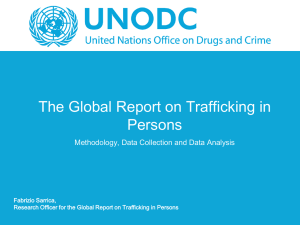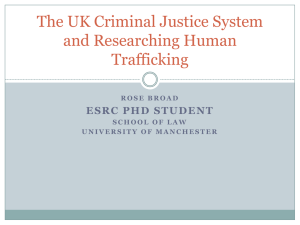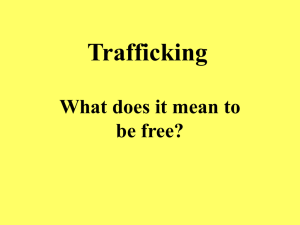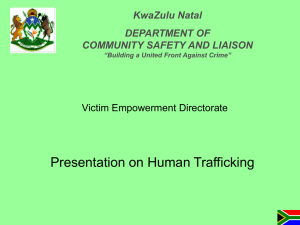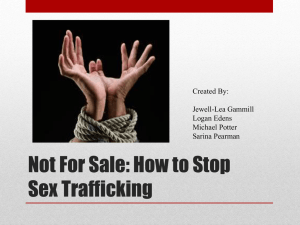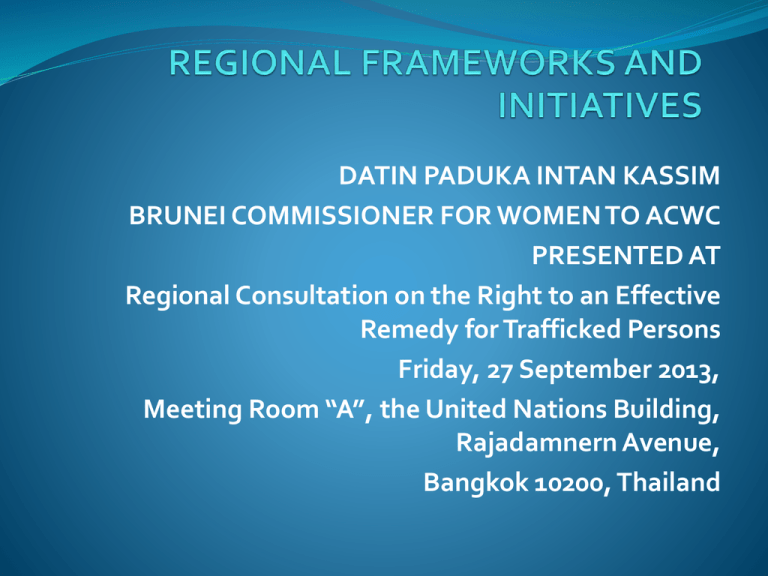
DATIN PADUKA INTAN KASSIM
BRUNEI COMMISSIONER FOR WOMEN TO ACWC
PRESENTED AT
Regional Consultation on the Right to an Effective
Remedy for Trafficked Persons
Friday, 27 September 2013,
Meeting Room “A”, the United Nations Building,
Rajadamnern Avenue,
Bangkok 10200, Thailand
REGIONAL INITIATIVES
ASEAN Declaration Against Trafficking in Persons Particularly
Women and Children (2004)
The document was adopted by ASEAN heads of state at
the 10th ASEAN Summit in Vientiane, Laos PDR on 29
November 2004.
the Declaration lays the groundwork for a regional
approach to preventing and combating trafficking in
persons. Member Countries reaffirmed their
commitment to intensify regional coordination and
cooperation among immigration and law enforcement
personnel, while respecting and safeguarding the dignity
and human rights of victims of trafficking.
.
2
Key commitments in the declaration include the
following:
Establishing a regional focal network to prevent and
combat trafficking in persons, particularly women and
children;
Adopting measures to prevent the fraudulent use of
passports, official travel documents, identity
documents and other documents;
Undertaking regular exchanges of views and
information on relevant migratory flows, trends and
patterns;
Strengthening border control and monitoring
mechanisms,
3
Enacting applicable and necessary legislation;
Intensifying cooperation among immigration and other law
enforcement authorities;
Distinguishing between the victims of trafficking and the
perpetrators;
Ensuring the victims are treated humanely, and provided
with essential medical and other assistance including
prompt repatriation;
Undertaking actions to respect and safeguard the dignity
and human rights of victims of trafficking;
Undertaking coercive measures against those engaged in
trafficking in persons, and offering the widest possible
assistance to punish these activities; and
Taking measures to strengthen regional and international
cooperation to prevent and combat trafficking in persons.
4
.
Work Plan to implement the 2004 Declaration
commits SOMTC and other parts of ASEAN to a broad programme of
activities in four areas:
Regional and international cooperation;
Law enforcement cooperation in the investigation of trafficking cases;
Prosecution and adjudication of trafficking cases; and
Victim and to strengthen their criminal justice responses within and
between ASEAN Member States protection and support.
The Work Plan encourages Member States to develop common standards
to prevent and combat trafficking in persons
5
ASEAN DECLARATION ON THE PROTECTION AND
PROMOTION OF THE RIGHTS OF MIGRANT
WORKERS (2007).
calls for improved migrant worker rights and welfare, as
well as taking steps to combat human smuggling and
trafficking.
identifies a number of key principles relating to migrant
workers as well as commitments on the part of receiving
States, sending states and the ASEAN community as a
whole.
6
ASEAN Committee on the Implementation of the
Declaration
Established in 2007, by ASEAN Foreign Ministers
This Committee is responsible for ensuring the
effective implementation of the commitments made
under the Declaration and facilitating the development
of an ASEAN instrument on the protection and
promotion of the rights of migrant workers.
7
Criminal Justice Responses to Trafficking in Persons:
Guidelines (2007) Criminal Justice Responses to
Trafficking In Persons : ASEAN Practitioner
Guidelines (2007)
- provide detailed guidance to criminal justice practitioners
on international cooperation as it relates to trafficking in
persons cases. These guidelines cover the major areas of
investigatory / prosecutorial / judicial responses to TIP
including evidentiary issues, mutual legal assistance and
extradition.
8
Mutual Legal Assistance Treaty (2004)
improves working relationships between security and law
enforcement agencies to enhance the regional response to
transnational crime. The MLAT establishes procedures for
requesting and providing assistance in the collection of
evidence for criminal investigations and proceedings.
9
ASEAN Declaration on Transnational Crime (1997)
emphasizes the importance of a unified regional approach to combating
transnational crime. The Declaration affirms the agreement of all ASEAN
Member States to take ‘firm and stern measures’ to combat transnational
crime, including the trafficking of women and children.
Member Countries agreed to the following measures to combat
transnational crime:
•To strengthen cooperation at the regional level;
•To expand the scope of their efforts;
•To convene an ASEAN Ministerial Meeting on Transnational Crime, as the
Peak ASEAN body to coordinate activities on transnational crime; and
To hold discussions with other Member Countries about bilateral and
regional agreements on issues such as mutual legal assistance.
10
The ASEAN Guidelines for the Protection of the Rights of
Trafficked Children
was developed by Asia ACTs to put in place mechanisms
that would prevent victims of child trafficking from further
exploitation.
This NGO initiative was adopted by the ASEAN Senior
Officials on Social Welfare and Development in 2007.
11
COUNTRY/COUNTRIES INITIATIVES
1. Prevention
and awareness campaign
Formation of website – cooperation with others
eg Asia Regional Cooperation to Prevent People Trafficking (ARCPPT)
website
ARCPPT is a three year Project funded by the Australian Government and
managed by ACIL Australia. Its goal is to contribute to the prevention of
people trafficking in South East Asia. The Project is working in four ASEAN
countries: Thailand, Lao PDR, Myanmar (Burma) and Cambodia
e.g The Asia Foundation website
multi-lingual anti-trafficking in persons Web site for Cambodia and
Thailand . It is intended to serve as a consolidated access point for countertrafficking NGOs, government officials, and other organizations in
Cambodia and across the region to find and share critical information on
human trafficking.
12
2. Cooperation efforts
• Mou between Thai Government and NGO
MoU on Common Guidelines and Practices for Government
Agencies Concerned with Cases of Trafficking in Women and
Children
MoU on the Procedural Cooperation between Government
and Non-Government Agencies working with Cases of
Trafficking in Women and Children
MoU on the Operational Guidelines of Non-Governmental
Agencies Concerned with Cases of Trafficking in Women and
Children
• Mekong sub-region initiatives
Ministerial meeting and senior official meetings
13
•Mekong Governments Agreement on Human
Trafficking
On 29th October 2004, in Yangon, the COMMIT
(Coordinated Mekong Ministerial Initiative Against
Trafficking) Memorandum of Understanding (MOU) was
officially signed by Ministerial representatives from
Cambodia, P.R. China, Lao P.D.R, Myanmar, Thailand and
Vietnam.
•The Philippine Government works with international
NGOs and foreign governments to combat human
trafficking in the Philippines and of Filipino migrants
abroad.
14
•Anti-trafficking Agreement Signed between Vietnam
and Thailand
The agreement signed is a move towards adopting a
standard operating procedure for victim identification and
repatriation, which includes the adoption by all regional
legal systems of the UN's definition of trafficked persons
15
REGIONAL STATUS
Some ASEAN countries are source and transit
- men, women, and children are trafficked for sexual and labor
exploitation within ASEAN countries itself and to other
region.
Some countries are destination country - men, women, and
children who are subjected to conditions of forced labor, and
women and children subjected to sex trafficking
Some ASEAN countries are major source country for women,
children, and men who are subjected to sex trafficking and
forced labor
16
ACWC Work Plan 2012-2016
ACWC has only been in existence for 3 years-inugerated in 2010.
Trafficking is one of the areas identified in the Work Plan o]f ACWC]
Children’s rights:
review existing practices on treatment/ management of victims
of trafficking (i.e. rescue, recovery, repatriation, rehabilitation,
reintegration, referral system, and assistance) of victims of trafficking
in women and children among country of origin, transit countries,
and receiving country to strengthen the assistance mechanism for
victims of trafficking
17
Women’s rights:
Promotion of “access of justice” among victims of VAW, focusing
on victims of trafficking by
-Formulation of gender sensitized modules on comprehensive
aspects of handling trafficking cases (e.g. referral system,
repatriation, services to victims, etc)
- followed by capacity building programmes for criminal justice
officials and social services providers.
f
18
CHALLENGES
• Political differences in approach and
National priorities
• Cost issues – trans border cooperation.
• Differences in the legal system
•Lack of awareness and knowledge on issue
• Corruption
19



